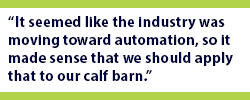
Virtual Farm Tour: Gar-Lin Dairy LLC
Gar-Lin Dairy LLC focuses on clear protocols, team development in autofeeder system
Gar-Lin Dairy LLC in Eyota, Minnesota, is a partnership between siblings, Dana Allen-Tully and Dean Allen, and their parents, Gary and Linda Allen. When Gary and Linda purchased the farm from Gary’s parents in the 1970s, they milked about 40 cows. The farm grew throughout the years to its current herd of 1,950 cows.
Allen-Tully works as the dairy operations manager and oversees calf management. Several years ago, she began exploring new calf facilities to replace their hutches and calf barn.
“I wanted to make an investment in our newborns,” she said.
Allen-Tully recognized the workforce was changing, and she wanted a system that provided a nice work environment for employees that also allowed for workflow efficiency. Autofeeders seemed like the right fit and construction on a new barn was completed in October 2016.
“It seemed like the industry was moving toward automation,” Allen-Tully said, “so it made sense that we should apply that to our calf barn.”
 Barn design
Barn design
Allen-Tully said she and the calves appreciate routine, so she designed the barn to minimize variation. Ten pens hold no more than 23 calves each, and the groups of calves do not vary by more than seven days of age. She said that keeps newborns from being pushed away from the feeders by older calves.
Pasteurized whole milk is brought to a central bulk tank in the calf barn. Buried 6-inch PVC pipe connects to each of the five GEA autofeeder rooms. Inside the PVC, PEX pipe allows milk to circulate continuously from feeder to feeder and back to the bulk tank. Allen-Tully said she likes this barn design because it allows her to observe calves from both the front and the back of each pen.
The youngest calves are placed in pens with Quattro feeders. Allen-Tully said she believes the young calves learn to use the Quattro feeders faster because, if they have milk allotted to them, it is available without waiting for another calf to finish. Calves also have the luxury of standing next to a “friend” when they are learning to use the feeder. Each group moves out of the Quattro feeder pens at 3.5 weeks of age. At that time, they move to a pen with one nipple per pen and stay until weaning. The calves stay in the same groups until they are four months of age.
Allen-Tully made ventilation a priority when designing the calf barn. She took a ventilation course with the Dairyland Initiative and installed positive-pressure ventilation tubes in the barn along with secondary tubes used for cooling during the summer. A thermostat on the side curtains opens and closes them according to the temperature.
Feeding program
SmartCare® is added to the milk at the bulk tank and Vita Plus Calf Magnify is added at the feeder. Calves are assigned to one of two feeding programs. Calves weighing more than 80 pounds at birth receive 7 liters of milk at two days of age and gradually increase to 9.5 liters at 12 days. Calves weighing less than 80 pounds receive 6 liters initially and gradually increase to 8.5 liters.
“We found the smaller calves really do benefit from the smaller feedings,” Allen-Tully said.
At 38 days of age, the larger calves’ feedings drop to 6 liters per day and the smaller calves decrease to 5 liters per day. After that, milk is gradually decreased until calves are fully weaned. Allen-Tully said, at first, she used a gradual step-down for the entire weaning process, but she found calves did not consume starter like they should. She said the initial large drop in milk volume spurs them to consume starter right away, allowing for a smoother transition. Calves stay in the autofeeder pen until three days after the youngest calf is weaned.
Success starts in maternity
Allen-Tully said the importance of optimal maternity care should not be overlooked as a key success factor with autofeeders. The team goes to great lengths to keep the maternity pen clean. Newborn calves are placed in individual pens and never comingled. Colostrum is pooled, heat-treated and stored in 2-quart bottles in the refrigerator. All colostrum is tested for quality before it’s fed. Calves receive Calf-Guard® and are tagged and dehorned using lidocaine and paste while in the individual pens. Allen-Tully said calves must consume 2 liters of milk before they move to the autofeeder pens.
Cleanliness, observation and team development
Allen-Tully said the focus on cleanliness throughout the calf program is paramount to success in the autofeeder barn. Bedding is kept dry, nipples are replaced twice a day, and the feeders are washed daily in addition to an acid wash twice a week.
“I don’t think you can be clean enough,” Allen-Tully emphasized.
While she loves the socialization group pens offer, she said calves must be closely observed for any indications of disease. Vince Migliazzo, and the calf team, Jenny Thill, Obed Utrera, and Eduardo Hernandez, spend a lot of time walking the pens to catch and address disease challenges early.
“I can’t emphasize enough the importance of a good calf team,” she said.
Allen-Tully goes to great lengths to create processes that make it fun and easy for employees to meet the farm’s high expectations for calf care. Employees are given many opportunities to learn and develop their calf management skills. Allen-Tully said this is essential because “I want them to be able to make decisions without me.” She said she believes employees should be empowered to make the best decisions for the calves right away and know that they can ask questions when they aren’t sure how to handle a situation.
“I really do have a great team,” she said. “These are people who are passionate about making sure those little babies feel good.”
| Category: |
Autofeeders Facility design Farm tours Starting Strong - Calf Care |

